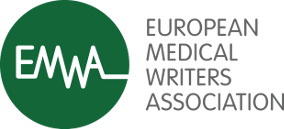Abstracts for Poster Presentation - Berlin 2022
P1 - Medical writing field awareness and the way forward: An online survey
Pinki Rajeev and Saurabh Shinde
INTRODUCTION
We aimed to identify awareness of medical writing professionals (MWP) regarding the medical writing field (MWF), associated growth opportunities, and the way forward.
METHOD
An anonymous survey comprising 12 multiple-choice/open-ended questions was administered to MWP globally from 13 August 2021 to 6 September 2021.
RESULTS:
MWP (N=185) across 17 countries, India (93), UK (29), EU (24), Japan (11), US (9), Canada (6), and others (13), responded to the survey.
Respondents were highly qualified with 87% having an MS/PhD/equivalent degree and MWF experience of 0–5 (26%), >5–10 (29%), >10–15 (24%), and >15 years (21%).
Respondents were employed as medical writers or in MWF-associated functions across pharmaceutical industries (67%), medical writing (MW) agencies (57%), or as consultants (21%) in different domains (Regulatory/Scientific/Medico-Marketing/HEOR). They scored professional growth opportunities as high to medium (92%). Top reasons for liking MWF were skill utilization (79%), creative thinking
(75%), contribution to patients’ lives (72%), and work flexibility (67%).
A majority (76%) of them were not aware of MWF during their graduation/post-graduation with 53% learning about MWF through friends/colleagues and 7% through campus recruitment; only 9% underwent professional training before entering MWF. Similar trends emerged among developing and developed countries.
To increase MWF awareness, 86% indicated that MW should be introduced at the university level. Other suggestions included workshops by pharmaceutical companies/MW agencies, job fairs, and MW courses.
CONCLUSIONS:
Although MWF offers good skill utilization and professional growth opportunities globally, there is still limited awareness, which needs to be addressed at the university level.
P2 - Utilizing Innovative Tools to Accelerate Regulatory Document Writing
Mauro Meloni, PhD, Early Clinical Medical Writing, ICON plc
Sara Fernandes, PhD, Early Clinical Medical Writing, ICON plc
Robert Panek, PhD, Early Clinical Medical Writing, ICON plc
Rona Grunspan, MD, Early Clinical Medical Writing, ICON plc
INTRODUCTION
Regulatory document writing requires a multidisciplinary approach which consumes time and resources. We developed a lean writing process by using innovative tools to reduce repetition, verbosity, grammar, and data errors to produce high quality documents while reducing timelines. We chose as a test case document the writing of a clinical study protocol.
METHODS
Based on a 10-question survey extended to approximately 100 medical writers (MWs) and real time projects conducted over a 2-year period, we developed a process that can reduce project timelines. Our method included a template checklist, developed by ICON MWs, PerfectIT as a proofreading tool, EndNote for management of citations, and PleaseReview for co-authoring, reviewing, and consolidating comments. Advantage was also taken of time zone differences that extend writing time and allow parallel writing and quality control.
RESULTS
Our results indicated that timelines can be reduced by approximately 35%. The protocol checklist mitigated section prone content errors, particularly, schedule of assessments, tables, study design, and eligibility criteria resulting in better consistency across protocol sections. The different software tools efficiently identified and corrected grammar, style and content errors, saved time by automating citation updates, and provided a window into all reviewers comments simultaneously, avoiding reviewer repetition. MWs working collaboratively proved to be able to shift workloads flexibly to break up unexpected bottlenecks.
CONCLUSIONS
Lean writing was achieved by applying innovative tools that produced high quality documents while markedly reducing timelines. These tools can be applied and tailored to other regulatory documents without sacrificing quality especially when delivery timelines are shortened.
P3 - Using Audio-video Abstracts to Enhance the Research Article - A Retrospective Observational Study
Namrata Singh, Turacoz B.V, The Netherlands
Shruti Shah, Turacoz Healthcare Solutions Pvt Ltd, India
INTRODUCTION
With a paradigm shift of accessing research to online platforms, medical journals use audio-video (AV) abstract for post-publication knowledge dissemination on social media platforms and enhance the target audience reach. The current retrospective study was undertaken to study the incidence and impact of publications with AV abstract (pAV) in medical journals.
METHODS
Research publications from high impact factor journals (New England Journal of Medicine [NEJM] and Lancet) and therapeutic area specific journals (Arthritis and Rheumatology [A&R] and Journal of Allergy and Clinical Immunology [JACI]) were screened from Jan-2016 till date, for pAV versus those without (pWAV). Altmetrics for impact of pAV will also be studied.
RESULTS
Of the total 6039 publications in NEJM from Jan-2016 till date, only 22% (n=1349) were pAV. Of these, 395 pAV (29%) were pharma-sponsored; 85 pAV (6%) involved medical writer. Percentage of pAV remained constant from 2016 to 2018 (16%) and increased from 2019 (19%) to 2020 (23%) and 2021 (33%). In Jan-Feb 2022, there were 37% pAV. Consistent with this, percentage of pWAV remained constant from 2016 to 2018 (84%) but reduced considerably thereafter (81% [2019], 77% [2020], 67% [2021]). In Lancet, of 2015 publications from 2016 to 2022, only 4 were pAV (n=2 in 2019, n=1 each in 2020 and 2021). There was no pAV in JACI and A&R.
CONCLUSIONS
Preliminary results indicate that although pAV is slowly gaining popularity, it is still sub-optimally adapted by authors/researchers and medical writers. This may be attributed to lack of awareness or inadequate skill sets required for developing AV abstract.
P4 - Perspectives on journal selection criteria from researchers working in a medium-sized biotech company
John Gonzaleza, Jane Bryantb, Kristian Clausenb, Sarah Grahamc, Jessica Naddafy-Clarka, Helen Woodroofb, and Slávka Barónikováa
aGalapagos NV, Mechelen, Belgium
bAspire Scientific Ltd, Bollington, UK
cOxford PharmaGenesis, London, UK
INTRODUCTION
This survey aimed to determine the most important factors for journal selection and most valuable publication enhancements from the perspective of researchers working in preclinical and early-phase programmes in a biotech company. This activity was part of a broader company programme to understand publication decisions and inform stakeholder education around good publication practice.
METHOD
A questionnaire was circulated to colleagues from early-development programmes who had been invited to publications strategy and planning workshops. Respondents were asked to rank, in order of importance, ten factors (1 being most important) they consider when selecting a journal for publication of their research, and to rank manuscript and poster publication enhancements by added value.
RESULTS
Responses were received from 31 team members. Factors viewed as of key importance/value (ranked 1 or 2) for journal selection were: journal impact factor, n=17; immediate access (no paywall), n=9; open access, n=8; rapid online access, n=7; Citescore, n=4; Altmetrics tracked, n=3; citation indices reported, n=3; social media presence, n=2; patient involvement, n=1; option to include enhancements, n=0. Manuscript enhancements scored as follows: visual abstracts, n=21; plain language summaries, n=14; supplementary materials, n=12; videos, n=6; podcasts, n=3. Poster enhancements scored as follows: Quick Response (QR) codes, n=20; video summaries, n=14; interactive features, n=11; plain language summaries, n=7; audio abstracts, n=2.
CONCLUSION
Early drug development researchers regarded impact factor as the most important consideration during journal selection, followed by immediate and open access. Visual abstracts and QR codes were ranked as the most important manuscript and poster enhancements, respectively.
P5 - Landscaping the terminology of lay and plain language document types
Adeline Rosenberg,1 Sarah Griffiths,1 John Gonzalez,2 Slávka Baróniková2
1Oxford PharmaGenesis Ltd, Oxford, UK; 2Galápagos NV, Mechelen, BelgiumINTRODUCTION
Regulatory Lay Language Summaries (LLS), publication-associated Plain Language Summaries (PLS) and Plain Language Summaries of Publications (PLSP) are three different document types, with distinct purposes, scope and audiences. This landscaping review outlines the variations of terms in use and aims to provide clarity on terminology.
METHODS
We manually searched websites of the 38 full and affiliate corporate members of the European Federation of Pharmaceutical Industries and Associations (EFPIA, which provides good practice guidance1 on LLS per the EU CTR no.546/2014, Annex V mandate2) for variations of LLS terminology; this search was performed on 16 February 2022.
RESULTS
Regulatory LLS are mandated summaries of clinical study reports for study participants. LLS have limited scope, reporting on one study only, and are intended to be hosted on the central Clinical Trials Information System portal.3
Publication-associated PLS are brief jargon-free summaries, primarily of peer-reviewed publications, for non-specialist readers. Formats vary, but best practice and convention encourage text-based and concise PLS, allowing indexing on PubMed to maximize discoverability. PLS should be peer-reviewed and hosted with their associated publication.
PLSPs are full-length, standalone secondary manuscripts that ‘translate’ previously published primary manuscripts into plain language with visual formatting, currently published by Future Science Group journals.4 PLSPs may include the patient voice and patient-authors for a wider scope.
The landscaping analysis revealed that among the 38 EFPIA members, there are 18 different terms for LLS in use, including 11 instances of using the term PLS to describe LLS. Additionally, PLS and PLSP may also be used interchangeably.
CONCLUSIONS
Evidently, there is confusion regarding terminology; medical publications professionals need to be aware of these differences and ensure precision when referring to these three document types to avoid further confusion. Standardization of terminology is necessary for further clarity and to promote appropriate usage.














